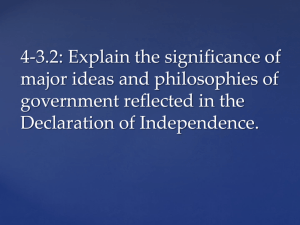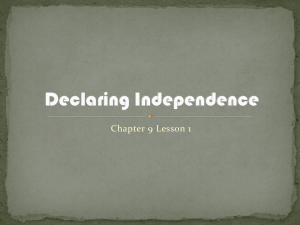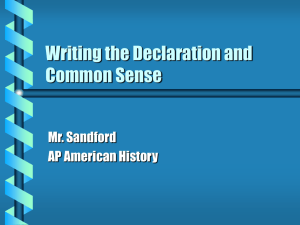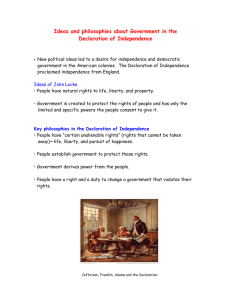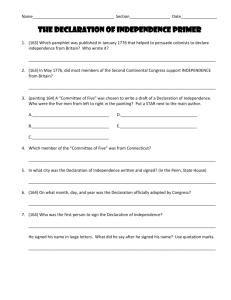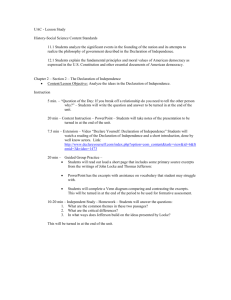Section 4.3 - Trimble County Schools
advertisement
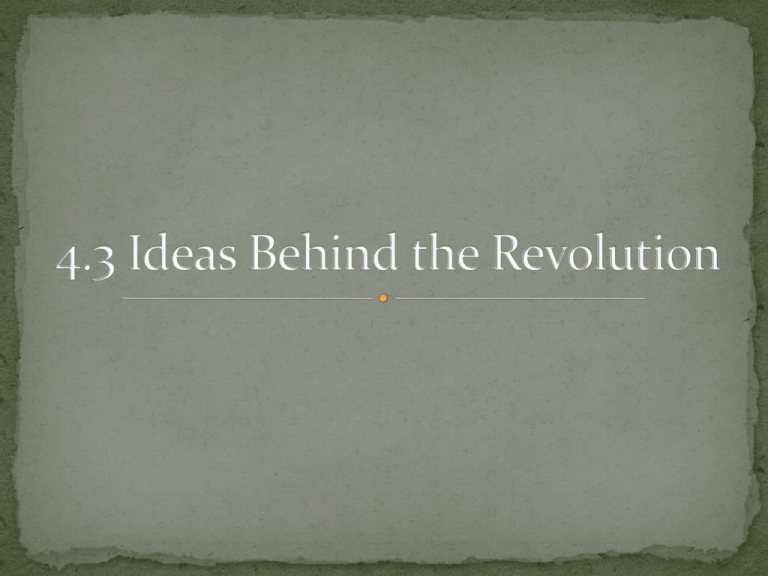
Bellringer: IDEALISTIC…briefly define this word and list some attributes of an idealistic person. Vocabulary: Common Sense Second Continental Congress Olive Branch Petition Declaration of Independence Enlightenment Natural rights I Can… 1. Describe the importance of Thomas Paine’s Common Sense. 2. Identify the four parts of the Declaration of Independence. 1. It was a power struggle between the American colonists and Great Britain over the question of who would rule them. 2. It was a Revolution of ideas. The colonists were rethinking the proper role of citizens, government, and the relationship between the two. Americans learned to demand that government respect citizens’ rights. A 47-page pamphlet written by Thomas Paine. It first appeared in Philadelphia in January 1776. Paine’s direct writing style suggested that anyone could understand the conflict between GB and the colonies. He simplified his writing avoiding references to Greek and Latin literature humanswers.net Within a year some 500,000 copies were sold. The pamphlet convinced many readers, including those who had favored a peaceful settlement of differences to support a complete break with Britain instead. dadditudes.com Common Sense appeared when the Congress was meeting in Philadelphia. They first met in May 1775, less than a month after the clash at Lexington and Concord. Most of the delegated from the First Congress returned along with Benjamin Franklin and John Hancock. Thomas Jefferson would arrive in June. kidport.com The delegates were deeply divided between independence and compromise. In November 1775, the Congress learned that George III had refused the Olive Branch Petition. Written by Dickinson, the document had expressed the colonists’ continued loyalty to the monarch and their desire for peace. It begged the king to halt fighting until a solution could be found. en.wikipedia.org In June of 1776, after more Members of the committee than a year of war, the Congress decided it was time for the colonies to cut their ties with Britain. The Congress appointed a committee to prepare a statement of the reasons for the separation – a Declaration of Independence were lawyer and planter Thomas Jefferson; Boston lawyer John Adams; Roger Sherman, a judge from Connecticut; Robert Livingston, the lawyer son of a wealthy New York family, and Benjamin Franklin. The committee chose Jefferson to draft the statement. Jefferson’s political ideas were influenced by the enlightenment, an 18th – century movement that emphasized science and reason as key to improving society. He also drew ideas from earlier political thinkers, such as John Locke. en.wikipedia.org Jefferson divided the D of I into 4 sections: an introduction, a declaration of rights, a list of complaints against the king, and a resolution of independence. 1. The introduction, or preamble explained the purpose of the Declaration. 2. The second section explained the political ideas behind the document. He drew on John Locke’s natural rights theory which stated that people had rights simply because they were human. He used the expression “inalienable rights” meaning they could not be taken away…life, liberty, and the pursuit of happiness. Locke stated people formed governments to protect their natural rights. If a government failed to act in the best interests of the people it governed, then the people had the right to revolt and replace the government with a new one. http://www.nndb.com/people/813/000055648/ On July 4, delegates joined in voting to approve the Declaration. It defined the basic principles on which American Government and society would rest. Ordinary citizens would have a strong voice in their own government. en.wikipedia.org 1. Summarizing the Main Idea: Describe some of the political ideas that influenced the outbreak of the American Revolution. How did the king’s rejection of the Olive Branch Petition contribute to the Declaration of Independence? Make a list of reasons Thomas Paine’s pamphlet was so important. Recap the 4 parts of the Declaration of Independence. Read the Declaration of Independence on pages 102 – 104. Complete Reviewing the Declaration on page 105.

